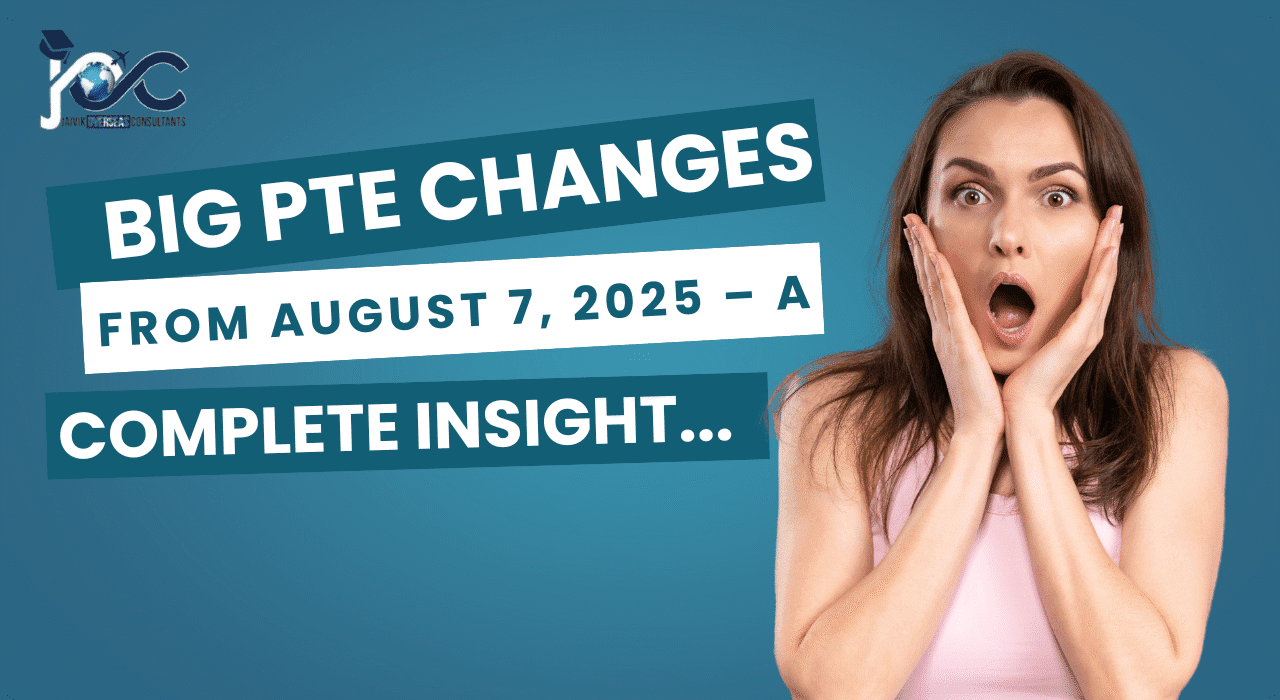Introduction
Embarking from August 7, 2025, the PTE Academic exam has undergone significant updates you’ll want to know. Whether you’re aiming to study abroad, applying for a PTE for work visa, or just want to excel, it’s crucial to understand these changes and prepare accordingly.
What are the new PTE Academic question types?
Pearson has introduced two new speaking tasks:
-
Summarize Group Discussion (SGD): Listen to a short group discussion among 2-4 people, then summarize the main ideas in your own words within a limited time.
-
Respond to a Situation (RTS): You’re presented with a brief scenario and must respond appropriately and naturally, testing real-world conversational skills.
How has the PTE exam scoring & evaluation changed?
Several key tasks—including the two new ones—now include human scoring in addition to AI-based scoring. This aims to ensure genuine, context-appropriate responses and discourages the use of over-rehearsed templates.
Will the PTE get longer or shorter?
The exam’s duration has been adjusted:
Some sources indicate a slightly shorter total time due to fewer questions, while others report an increase to about 2 hours and 15 minutes.
This difference appears tied to whether tasks have been reduced overall or expanded with the two new additions.
For accurate timing, confirm your test format with your registration confirmation or Pearson’s official site.
What else has changed in the PTE test format and structure?
-
The number of tasks has subtly adjusted—some tasks have been reduced or removed.
-
Summarize Written Text is now just one question, fewer Listening MCQs, etc.
-
A refreshed user interface, including improved navigation, accessibility, and layout.
How to prepare effectively for the updated PTE Academic 2025 format?
1. Practice Summarize Group Discussion (SGD) smartly:
-
Listen actively—identify main ideas and who said them.
-
Take quick, focused notes.
-
Speak clearly within 20–120 seconds.
-
Use linking words (“however,” “meanwhile”) and attribute ideas to speakers.
2. Master Respond to a Situation (RTS) effectively:
-
Understand the scenario—note the tone (formal vs casual).
-
Structure: greeting → acknowledge → respond → close.
-
Avoid template-like phrasing.
3. Avoid templates—they can hurt your score:
Human scorers are now looking for authenticity. Memorized responses can result in lower scores—even a zero.
4. Practice with updated mock tests:
-
Use PTE practice tests online that reflect the new tasks.
-
Focus on fluency, time management, and adapted speaking style.
5. Focus on fluency, pronunciation, and coherence:
-
Speak naturally with good intonation.
-
Use everyday vocabulary instead of overly complex words.
conclusion
The PTE Academic changes from August 7, 2025 mark a new era for test-takers aiming for study, work, or migration opportunities abroad. With the introduction of Summarize Group Discussion and Respond to a Situation, along with human scoring, the focus has shifted toward real-life communication skills and authenticity. Preparing for these updates is crucial to achieving a high score.
At Jaivik Overseas Consultants, we specialize in PTE coaching, offering updated training methods, mock tests, and personalized strategies tailored to the new format. Whether your goal is to study abroad or secure
People Also Ask — Key FAQs
Q1: What changes are introduced in PTE Academic from August 2025?
A: Two new speaking tasks: Summarize Group Discussion and Respond to a Situation. Some tasks are removed or reduced, UI improved, and human scoring added.
Q2: Are templates still allowed in these new tasks?
A: Templates are strongly discouraged—human evaluators may penalize robotic responses.
Q3: How long is the new PTE exam?
A: Around 2 h 15 min, depending on task count—verify with Pearson’s official site.
Q4: Which tasks are now scored by humans?
A: New speaking tasks (SGD and RTS) plus Describe Image, Retell Lecture, Summarize Written Text, Summarize Spoken Text, and Essay.


